White Coat Ceremony Celebrates the Next Generation of Physicians
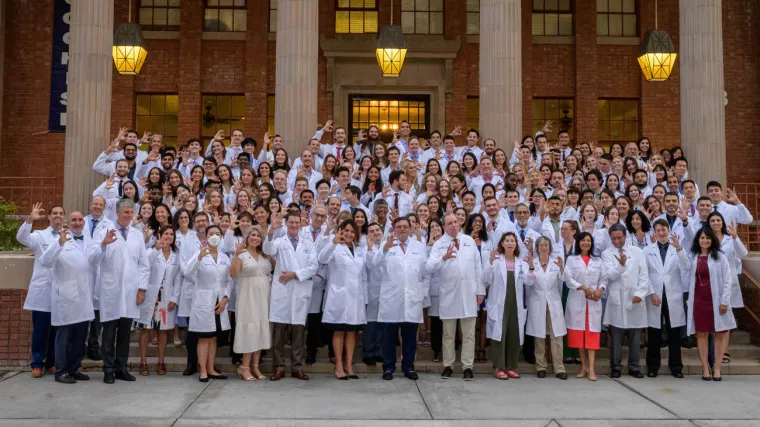
Members of the University of Arizona College of Medicine – Tucson Class of 2026 took part in a White Coat Ceremony recognizing their entry into medicine with their first physician's white coat, the garment of their future profession.
"In tonight's ceremony, you will don the doctor's white coat and recite and sign a mission and vision statement that recognizes the special bond you will develop with your colleagues and your teachers, and that you will establish with your patients over the next four years," Kevin Moynahan, MD, the college's vice dean for education and a professor of medicine, told students.
The White Coat Ceremony is a rite of passage in most U.S. medical schools. The first University of Arizona College of Medicine – Tucson White Coat event was held in 1995 and has been a tradition for incoming medical students ever since. The Arnold P. Gold Foundation established the first white coat ceremony in 1993 at Columbia University in New York.

Celia P. Valenzuela, MD, interim vice dean for diversity, equity and inclusion, assistant professor of obstetrics and gynecology and a member of the College of Medicine – Tucson Class of 2002, spoke at the ceremony.
"When you put on your white coat today, you will officially become a physician in training," Dr. Valenzuela said. "No other rite of passage has ever carried so much symbolism and meaning for me. The memory of this moment, along with the oath that you will soon take, will be something that you will carry with you for the rest of your life."
She also spoke about the importance of establishing trust with patients.
"The ability to establish a connection with patients is what makes a physician most impactful. It's how we build trust," she said. "Get to know your patient. Ask them about their families, their culture, why they're there to see you, what their fears are, what they hope to get out of their visit with you."
Class of 2026
The Class of 2026 is 57% female and 43% male, with ages ranging from 21 to 32. Of 120 students, 103 are from Arizona, 37 are from Tucson and 20% are first-generation college students.
Below are a few of the students who participated:
Angela Rosé Monetathchi: 'A passion to give back'
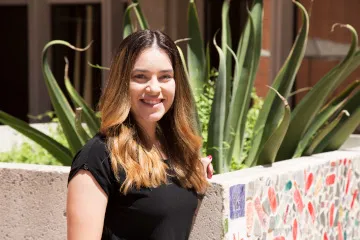
Angela Rosé Monetathchi's love of medicine was forged in a freshman honors biology class in high school. She could relate the subject matter to her family background, with healers on both sides — a urologist and a Comanche medicine man.
Her urologist grandfather lived a few hours away from her hometown outside Palm Springs.
"Anytime we were sick, my mom would call him and everyone would feel better just talking to him," she recalls. "He was good at what he did, and communicated really effectively. Just watching that interaction, I wanted to be that person, too."
Later in high school, Monetathchi enrolled in a theater class — and a couple of years later, entered Chapman University as a theater major. Unfortunately, the theater program wasn't a good fit, and at the same time, she was stricken with appendicitis.
"Being in the hospital reminded me that I loved that environment — the nurses, the doctors, the staff," she recalls. "When I went back to school, I went to my adviser and said I wanted to be a bio major."
Unfortunately, her adviser discouraged her, saying it would take too long.
"I was young, so I listened," Monetathchi says. "I graduated with a bachelor's in psychology. I didn't know what to do with that degree. I asked myself, if I could be anything — and time, age, none of that mattered — what would I be? It was really clear: Just be a doctor already. I finally committed to that."
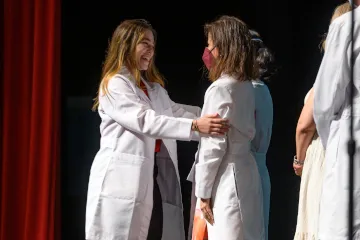
That commitment involved a move to Tucson, which was more affordable than Southern California — and brought her closer in spirit to Papa Ed, her family's name for her father's uncle, who had lived in Tucson.
"He was the first traditional medicine man on staff at St. Mary's Hospital," she says, referring to the Tucson hospital that was the first in the nation to incorporate traditional Native healing into its care. "He passed when I was fairly young, so it's been wonderful to make connections with people who knew him. As I get further down this road, his teachings are becoming even more important to me."
Those teachings involved a conception of the doctor as a facilitator in a patient's healing.
"It's my understanding, based on the traditional medicine that has been woven into my upbringing, that a doctor's role is not healing the person, but helping them heal. And yes, I believe there is more than one way to heal," Monetathchi says.
Working full-time, Monetathchi slowly chipped away at her medical school prereqs. She also connected with Jennifer Erdrich, MD, MPH, MFA, assistant professor of surgery, to support a research project on health disparities in breast cancer.
"I'd never done any research, but I had just taken a cancer biology course — one of my favorite prereqs I've taken — and here's this amazing opportunity to do cancer research with an American Indian physician," she says. "I didn't grow up on a reservation, and I'm not as connected with my tribe as I would like to be. It opened my eyes to the disparities out there, and it sparked a passion to give back to my community and help in any way I can."
Atehkeng (Ateh) Zinkeng: 'A beacon of hope'

As a child in Cameroon, Atehkeng (Ateh) Zinkeng, PSM, dreamed of being a soccer player. Then, at the age of 12, he saw with his own eyes the power and promise of medicine when his little brother was hit by a car, suffering a complex fracture in his leg. With no orthopedic surgeons in the city, his brother was at risk of losing his leg — until missionary doctors arrived in the region.
"I remember seeing the X-ray pictures, and these little screws going between the bones. I'm like, 'I would like to be like this guy someday.' I wanted to study medicine and use it as a beacon of hope for others," he says.
A few years later, when Zinkeng was a teenager, his family endured another health crisis, but this time they had no access to the necessary medical professionals.
"My father was diagnosed with glioblastoma, a severe form of brain cancer," he says. "Even with the best health care, the chances of recovery are slim. But I do believe the lack of experts contributed to how soon he passed away."
Zinkeng went on to earn a bachelor's degree in medical laboratory science from the University of Buea, and soon moved to Tucson, where he had friends and family. He enrolled in the University of Arizona's Applied Biosciences Program, earning a master's degree in diagnostic laboratory sciences.
"My interest in research ignited during my graduate school years," he says. "One of the highlights of my time at the University of Arizona was working on a clinical trial that led to FDA approval for a new rapid molecular diagnostic assay for coccidiomycosis, or Valley Fever."
His master's degree opened doors to a comfortable career path, but after several years in industry, he couldn't shake the memories of looking at his little brother's X-rays in awe, hoping to be like that doctor someday.
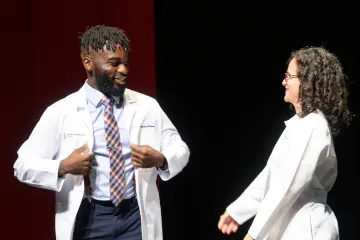
"I've been able to work in some of the best biotech companies in the nation, but I wanted to do more. I needed to pursue my dream," he says of his decision to return to Tucson to continue his education. "I can't wait to give back to this lovely community that welcomed me with open arms. I'm really excited to be back here."
Zinkeng enrolled in the MD-PhD program to feed his passion for both medicine and research. His early memories in Buea, where doctor shortages and high costs put medicine out of reach for so many people, keep him motivated.
"I remember going to the hospital with my grandma. We got there at 8 a.m. and ended up not seeing a doctor until 5 p.m. It makes it difficult to go to the hospital knowing that you have to wait several hours to see a doctor. And affording medical care is not easy, because a lot of people don't have good-paying jobs or are not working," he says. "The vulnerable and underserved communities are close to my heart. Being able to serve such communities and reduce the gaps in our health care systems is important to me."
Eddie Vargas: 'I remember being excited to go to the doctor'
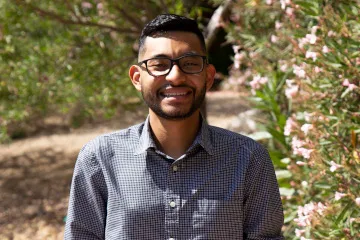
First-generation college student Eddie Vargas, who describes himself as "Tucson born and raised," has been connected to the University of Arizona since childhood, when his family received care at University Medical Center, then a part of the College of Medicine – Tucson. It was there that he got his first taste of medicine when he interpreted for his parents, who were immigrants from Nicaragua.
"There'd be really long words, and the doctors would explain what they meant," Vargas recalls. "I would learn things I never expected to learn, like high blood pressure, and then would have to translate. Growing up, that's a lot of what drew me to medicine."
In the 10th grade, the pull toward medicine grew even stronger.
"I was diagnosed with chronic ITP," Vargas says, referring to immune thrombocytopenia, a clotting disorder that causes excessive bruising and bleeding. "I had an amazing team of physicians. Seeing everyone come together, I thought, 'This is definitely what I want to do. This is how I want to impact others.'"
His pediatrician, Maria Theodorou, MD, clinical assistant professor of general pediatrics, encouraged Vargas's interest in medicine by answering his questions about the field and introducing him to medical students during his appointments.
"She's a huge reason why I decided to go to medical school," Vargas recalls. "She was always encouraging: 'You're gonna do it, Eddie! You're gonna be such a great doctor!' I remember actually being excited to go to the doctor."
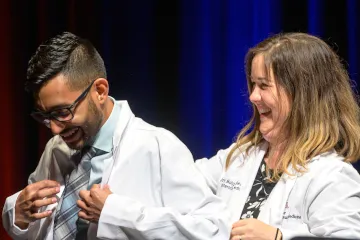
At the same time, his mentors at Canyon Del Oro High School were connecting him to some of the University of Arizona's many exciting opportunities. First, he enrolled in the College of Science's BIOTECH Project, investigating the effect of antioxidant-rich blueberries on the lifespan of a tiny roundworm called Caenorhabditis elegans. This work led to recognition at a science fair held by the Southern Arizona Research, Science and Engineering Foundation.
"I don't know if that research meant anything, but as a high schooler, it's the coolest thing ever to see C. elegans under a microscope," he says.
His interest in science piqued, Vargas enrolled in the University of Arizona as an undergraduate, eventually earning his bachelor's degree in neuroscience and cognitive science, focusing on neurobiology. To put himself through school, he found work in his chosen field, including as an activities coordinator in a home for people with Alzheimer's disease and a scribe at Tucson Medical Center.
"That was the first time I'd worked with physicians, seeing the most interesting parts to the saddest parts of the real-life experiences of medicine," he says. "They taught me a lot."
He also gained hands-on lab experience studying Parkinson's disease under the mentorship of Julie Miller, PhD, associate professor of neuroscience and speech, language, and hearing sciences.
"I learned so much about the nitty-gritty parts of research," he recalls. But he found himself fixated on what comes next after discoveries in the lab. "Studying the molecular biology is important, but I realized there was another aspect I really longed for: the patient side of it. That's where I made the turn from molecular biology to medicine. Each step has provided confirmation that this is what I was meant to do."
Hailey Lynn Patterson: 'I could step into their shoes'
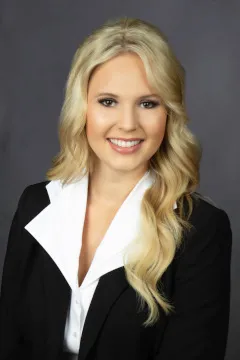
When she was 12 years old, Tucson native Hailey Lynn Patterson was stricken with a mysterious malady.
"I was home sick more than I was at school, and visiting medical offices several times a week was normal — I felt at home there," she recalls. "After over a year of testing, it was determined that I was a needle in a haystack, with an unusual virus that took over a year to completely recover from."
She may have been feeling back to normal, but the experience left an indelible mark.
"From a scary experience at such a young age came a lot of curiosity," she recalls. "I was inspired by those physicians who devoted their knowledge, determination and passion to my needs. I wanted to find a way to involve myself in that setting."
In high school, she was laser-focused on her goal of becoming a doctor, loading up her schedule with science classes and STEM extracurriculars. Her enthusiasm for service was developed through her involvement with the local chapter of a national philanthropic organization.
"Assistance League of Tucson allows you to feel fully immersed when you're volunteering. You are alongside the people you're helping. I'm energized by the fulfillment I get knowing I positively touched someone's life," Patterson says. "Medicine allows you the privilege to do this day in and day out."
Her work with the Assistance League of Tucson continued when she enrolled at the University of Arizona and spearheaded the effort to create a national-level group for college students and young professionals — earning her recognition as one of Tucson's 40 Under 40 in 2018.
"It showed me that what I was doing was making a difference," Patterson says. "It was a boost of confidence and a reminder to keep going."
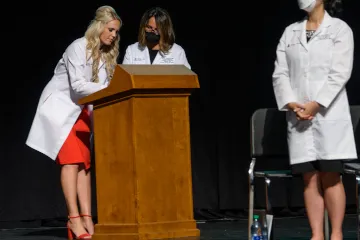
At the same time, Patterson spent her undergraduate years in the lab of Marvin Slepian, MD, Regents Professor of Medicine, where her eyes were opened to the excitement of bench-to-bedside research.
"We use motion tracking to track the progression or recession of disease states, like heart failure and arthritis," she says. "We'd walk right down to the fourth floor of the hospital and record data on heart failure patients, and bring it back to the lab at the Sarver Heart Center to study it."
In 2019, Patterson graduated with honors from the College of Medicine – Tucson with a bachelor's degree in physiology and a minor in Spanish. Her work in the Slepian Lab piqued Patterson's interest in the research distinction track, which prepares medical students to incorporate research into clinical care.
"Thanks to Dr. Slepian's lab, I discovered you can do both," she says.
Patterson believes her childhood illness as well as her philanthropic passions will help her relate to her young patients.
"Having lived it, I think I could step into their shoes and understand a child who is overwhelmed and doesn't quite understand all that's going on," she says. "I know, hands down, that I'm passionate about working with youth. I think my heart is going to pull me toward pediatrics. Through youth, pediatricians are shaping the future."
Nandini Sodhi: 'A lifetime of service'
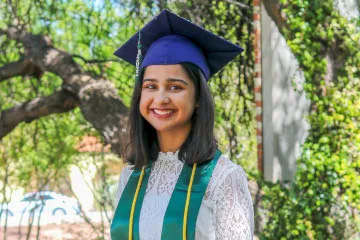
Nandini Sodhi has been on a path toward medicine for most of her life.
"As a little kid, I thought it was the coolest profession ever that you could 'fix' people," she says.
Her love of science deepened in high school, though by then she was leaning more toward a career in a pharmaceutical lab. She was eyeing out-of-state universities when her family situation changed dramatically.
"My grandparents moved from India to stay with us because my grandfather was struggling with his health, which was later diagnosed as Parkinson's," Sodhi recalls, explaining why she decided to stay in Tucson. "I was excited to be at home. The University of Arizona was a really cool place. Everywhere I went, I was met with warmth."
As an undergraduate, Sodhi explored her options, eventually returning to her early-childhood fascination with a doctor's ability to "fix people." She dipped her toe into the field, first as a student intern at Banner – University Medical Center.
"My job was to play with children. I spent a lot of holidays there on purpose — Mother's Day, Christmas Eve — I just loved it," she says. "It grounded me and I enjoyed the hospital setting. It was a great steppingstone into medicine."
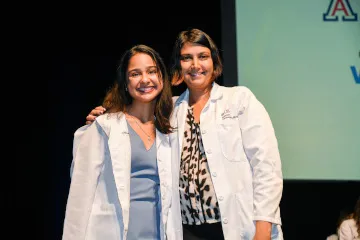
Later, she shadowed physicians at the Mayo Clinic in Phoenix.
"You got to see how physicians interact," she says. "You pick what traits you would like to take from another physician, and say, 'This is what I want to do in the future.' That was a powerful experience."
By the time she was wrapping up the requirements for her bachelor's degree in physiology, she applied to W.A. Franke Honors College MedCat Early Assurance Program (HEAP), which would guarantee acceptance to the College of Medicine – Tucson. By this time, she didn't have her sights set on an out-of-state school.
"My heart was at the University of Arizona," she says. "I love the faculty, and their mission statement aligned with mine — a school that values rural health, serving underserved communities, and many clinical opportunities for students through all four years."
Her interest in rural health dates back to her early childhood, when Sodhi's family lived in rural communities before settling in Tucson. As an undergrad, she was shocked to learn about parts of the country where health care was difficult to access, and she hopes to serve these communities as a primary care physician by forging strong relationships with her patients.
"As a physician, you talk to a patient about the most intimate parts of their life. Each one has a new perspective, and I add that to my perspective of life. That's something that drew me into medicine," she says. "This is a lifetime of service."
Her commitment to service was recently deepened when she experienced firsthand the enormity of the role health and medicine plays in families' lives.
"My mom passed away last year, and it was a sudden passing. Being there for my sister, my dad, my grandparents, I've learned to value family," she says. "Even when crisis strikes, it's given me insight that I can use to relate to patients, and helped me become a better student and person."
Nathan Kummet: 'There are so many doors you can go through'
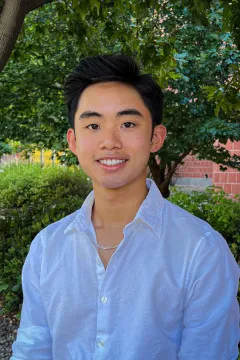
Chandler native Nathan Kummet didn't know where his interest in science would take him when he enrolled at the University of Arizona, but he was excited to explore. Internships, volunteer work and lab experience led to a double major in physiology and public health, and to the W.A. Franke Honors College MedCat Early Assurance Program (HEAP), which would guarantee acceptance to the College of Medicine – Tucson.
Since freshman year, Kummet has worked in the lab of Nafees Ahmad, PhD, professor of immunobiology, studying the genetic characterization of a gene that is essential for HIV-1 infection and replication in the body. Not only did he learn enough about HIV genetics to fill an honors thesis and a paper that he's preparing for publication, he also gained insight into the process of basic science.
"Science is not as perfect as we learn it in the classroom," he says. "Working in a research lab, half the time it doesn't work. Sometimes it's discouraging, but you push forward knowing that your research could potentially help a lot of people."
An internship with the Community Research, Evaluation & Development (CRED) team through the College of Agriculture and Life Sciences introduced Kummet to addiction medicine and community health. Through his work with a Drug Treatment Alternative to Prison (DTAP) program, he learned how the implementation of public health policies can improve the health of communities.
"Participants with drug addictions and a felony criminal offense will go into a treatment program instead of prison. I think it's really important that we treat addiction as a disease rather than a crime," he says. "I became interested in how health care policy and the actual practice of medicine can work together."
Kummet worked a lot of other service into his busy schedule, which was also packed with academics and paid work at a hotel. It was the perfect recipe to create a future physician.
"I want to be a physician because it gives you the chance to make a difference in people's lives," he says. "One of my favorite things is having that direct contact with people to build meaningful relationships."
Thanks to the HEAP program, he knew he was going to medical school before the end of his junior year.
"Our entire senior year, we weren't worrying about paying application fees, traveling for interviews, secondary apps — we knew we were in," he recalls. "It was almost like a gap year. It gave me so much more time to focus on the lab, getting all the data analyzed and this paper published."
Thinking about his future as a physician, Kummet is eyeing primary care, and is leaning toward pediatrics or psychiatry. But time will tell where his interests dovetail as he spends the next four years homing in on his specialty.
"My philosophy is to find things you're really passionate about and do them. I love working with kids, and I want to be involved in creating policy where underserved and rural populations have better access to care," he says. "As a physician, there are so many doors you can go through."
Contacts
Anna C. Christensen

